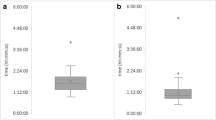Abstract
This study was set up to assess the performance of the Reveal® rapid AST system to determine the drug susceptibility of Pseudomonas aeruginosa strains directly from blood cultures. Two hundred fully sequenced clinical P. aeruginosa strains were selected for the evaluation, of which 26.5% (n = 53) produced transferable β-lactamases, and 2.0 to 33.0% had susceptibility levels close to the EUCAST 2021 breakpoints of 11 commonly used antipseudomonal antibiotics. The Reveal® AST system was run with a commercial MIC microplate designed for fast-growing Gram-negative bacilli (Microscan Neg MDR MIC 1), and was compared to the manually operated GN6F MIC microdilution panel from Thermo Fisher, as a comparator method. The Reveal® AST system provided MIC results for the 11 antipseudomonal antibiotics tested within a mean time to result of 6 h 22 min. By comparison with the GN6F panel, the overall rates of categorical agreement (CA), very major errors (VME), major errors (ME), and minor errors (mE for meropenem only) were 96.1%, 1.6%, 4.2%, and 0.6%, respectively. The Specific Reveal® AST system appears to be a reliable and fast technology to determine the susceptibility of P. aeruginosa to antibiotics, including those with resistance levels near categorical breakpoints, directly from blood cultures.
Similar content being viewed by others
Data availability
All the data are available on request from the corresponding author (PP). Complementary information is provided as supplemental material (Table S1).
Code availability
Not applicable.
References
van Delden C (2007) Pseudomonas aeruginosa bloodstream infections: how should we treat them? Int J Antimicrob Agents 30(Suppl 1):S71-75
Micek ST, Lloyd AD, Ritchie DJ, Reichley RM, Fraser VJ, Kollef MH (2005) Pseudomonas aeruginosa bloodstream infection: importance of appropriate initial antimicrobial treatment. Antimicrob Agents Chemother 49:1306–1311
Recio R, Mancheno M, Viedma E, Villa J, Orellana MA, Lora-Tamayo J, Chaves F (2020) Predictors of mortality in bloodstream infections caused by Pseudomonas aeruginosa and impact of antimicrobial resistance and bacterial virulence. Antimicrob Agents Chemother 64(2):e01759–19
van Belkum A, Burnham CD, Rossen JWA, Mallard F, Rochas O, Dunne WM Jr (2020) Innovative and rapid antimicrobial susceptibility testing systems. Nat Rev Microbiol 18(5):299–311
Giacobbe DR, Giani T, Bassetti M, Marchese A, Viscoli C, Rossolini GM (2020) Rapid microbiological tests for bloodstream infections due to multidrug resistant Gram-negative bacteria: therapeutic implications. Clin Microbiol Infect 26(6):713–722
Lim SH, Mix S, Xu Z, Taba B, Budvytiene I, Berliner AN, Queralto N, Churi YS, Huang RS, Eiden M, Martino RA, Rhodes P, Banaei N (2014) Colorimetric sensor array allows fast detection and simultaneous identification of sepsis-causing bacteria in spiked blood culture. J Clin Microbiol 52(2):592–598
Tibbetts R, George S, Burwell R, Rajeev L, Rhodes PA, Singh P, Samuel L (2022) Performance of the Reveal rapid antibiotic susceptibility testing system on Gram-negative blood cultures at a large urban hospital. J Clin Microbiol 60(6):e0009822
Akerlund A, Jonasson E, Matuschek E, Serrander L, Sundqvist M, Kahlmeter G, Group RS (2020) EUCAST rapid antimicrobial susceptibility testing (RAST) in blood cultures: validation in 55 European laboratories. J Antimicrob Chemother 75(11):3230–3238
Acknowledgements
The authors thank Martin Rottman for reviewing the manuscript.
Funding
DF, MB, and KJ are public officials whose salaries were supported by the Centre Hospitalier Universitaire of Besançon, France. Specific Diagnostics (LR, PR, PS) provided the material and reagents necessary for the study, as well as the funds to hire JC as laboratory technician.
Author information
Authors and Affiliations
Contributions
As follows: study design (PP, DF, KJ, LR, PS), bacterial collections (DF, KJ, PP), experimental work (JC, MB, DF), data analysis (DF, PP), draft preparation (PP, DF, KJ).
Corresponding author
Ethics declarations
Ethics approval
This in vitro study did not require specific ethical review or consent.
Consent to participate
Informed consent was obtained from all individual participants included in the study.
Consent for publication
Informed consent was obtained from all individual participants included in the study.
Conflict of interest
The authors JC, DF, MB, KJ, and PP declare to have no specific conflicts of interest. LR, PR, and PS belonged to the staff of Specific Diagnostics at the time of experiments. They did not interfere with the process of data production or their interpretation.
Additional information
Publisher's note
Springer Nature remains neutral with regard to jurisdictional claims in published maps and institutional affiliations.
Supplementary Information
Below is the link to the electronic supplementary material.
Rights and permissions
Springer Nature or its licensor (e.g. a society or other partner) holds exclusive rights to this article under a publishing agreement with the author(s) or other rightsholder(s); author self-archiving of the accepted manuscript version of this article is solely governed by the terms of such publishing agreement and applicable law.
About this article
Cite this article
Couchot, J., Fournier, D., Bour, M. et al. Evaluation of the Reveal® rapid AST system to assess the susceptibility of Pseudomonas aeruginosa from blood cultures. Eur J Clin Microbiol Infect Dis 42, 359–363 (2023). https://doi.org/10.1007/s10096-023-04556-2
Received:
Accepted:
Published:
Issue Date:
DOI: https://doi.org/10.1007/s10096-023-04556-2



